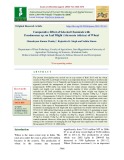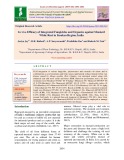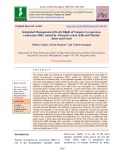
Fungicide and integrated disease management
-
Fusarium wilt has become a serious problem in recent years in all chilli growing irrigated tracts of India. Wilt of chilli (Capsicum annuum) caused by Fusarium oxysporum f.sp. capsici. In present investigation bio-agents, botanicals and fungicide were evaluated in-vitro and in vivo condition against Fusarium oxysporum.
 11p
11p  chauchaungayxua12
chauchaungayxua12
 29-07-2021
29-07-2021
 7
7
 1
1
 Download
Download
-
Many systemic and non-systemic fungicides were reported to manage the powdery mildew of capsicum. The information on the efficacy of new fungicides against powdery mildew of capsicum is insufficient. By considering the seriousness of disease and the economic damage/exorbitant losses caused by the disease, the present investigation was carried out by using integrated management approach using new molecule fungicides, botanicals and organic amendments for their efficacy to suppress powdery mildew of chilli under field condition.
 6p
6p  chauchaungayxua10
chauchaungayxua10
 18-03-2021
18-03-2021
 16
16
 2
2
 Download
Download
-
Stem and root rot disease caused by Macrophomina phaseolina (Tassi) Goid is the destructive disease in sesame. The effect of bioagents and newer molecules of fungicides were evaluated in managing the stem and root rot disease of sesame under sick plot conditions during 2018 and 2019.
 7p
7p  chauchaungayxua10
chauchaungayxua10
 18-03-2021
18-03-2021
 7
7
 2
2
 Download
Download
-
Turmeric (Curcuma longa L) rhizome rot caused by Pythium aphanidermatum was one of the divesting disease and causes accountable losses. All fungicides, bioagents, botanicals and soil amendments (alone and in combination) tested in vitro for management of turmeric rhizome rot was found effective against P. aphanidermatum.
 7p
7p  trinhthamhodang1218
trinhthamhodang1218
 26-02-2021
26-02-2021
 10
10
 2
2
 Download
Download
-
Trichoderma spp. are tolerant and compatible with fungicides, biofertilizers and other bio pesticides. Integrating fungicide resistant antagonists with suitable fungicide treatment has importance in the frame work of integrated disease management. Incorporation of natural products provides a viable solution to the environmental problems caused by synthetic pesticides. Identification of these compounds and their further testing may be an effective approach to minimize the use of hazardous chemicals
 5p
5p  trinhthamhodang1216
trinhthamhodang1216
 19-11-2020
19-11-2020
 10
10
 1
1
 Download
Download
-
A wide range of pathogens (fungi, bacteria, and viruses) affect the productivity of cucumber crop, which renders its production uneconomical. Therefore, an integrated approach was developed for the management of prevalent diseases of cucumber like damping-off and downy mildew using strategies such as growing border crop, use of reflective mulches, soil application and spray of fungicides and insecticides.
 7p
7p  kethamoi7
kethamoi7
 26-08-2020
26-08-2020
 15
15
 2
2
 Download
Download
-
Collar rot (Sclerotium rolfsii Sacc.) of chilli (Capsicum annuum L.) is one of the devastating soil-borne diseases of fungal origin, due to which 16–80% yield loss is recorded annually according to the severity of the disease. An integrated disease management approach was developed for the management of collar rot of chilli using fungicide, biocontrol agents and an organic amendment.
 8p
8p  nguaconbaynhay7
nguaconbaynhay7
 15-08-2020
15-08-2020
 20
20
 1
1
 Download
Download
-
Study carried out of this disease over a period of time revealed that Rhizoctonia solani Kuhn affects the yield severely whenever it occurs at any stage of the crop. In spite chemical measures like copper oxy chloride is recommended based on the previous studies on Rhizoctonia spp., the new fungicides need to be evaluated to find out the effective and economic fungitoxicants with which the disease can be controlled. Keeping in mind the seriousness of the disease, it was planned to elucidate the biocontrol and fungicidal capacity as soil and seed treatment against the pathogen, R.
 8p
8p  angicungduoc6
angicungduoc6
 22-07-2020
22-07-2020
 7
7
 1
1
 Download
Download
-
Compatibility of biocontrol agents viz., Trichoderma viride, T. harzianum and P. fluorescens were studied with four Fungicides viz., Thiram @0.3%, Carbendazim @0.1%, Captan @0.3%, fosetyl AL @0.2%, in favour of tolerance to fungicides. It was indicated that radial growth of fungal biocontrol agent Trichoderma viride was significantly inhibited (100%) with Thiram (0.3%) and Carbendazim (0.1%). Growth of T. harzianum was also 100 per cent inhibited with Carbendazim (0.1%). Whereas, both fungal biocontrol agents had recorded compatible with Fosetyl AL (0.2%), which have less (57.59% and 1.
 6p
6p  chauchaungayxua6
chauchaungayxua6
 26-06-2020
26-06-2020
 8
8
 0
0
 Download
Download
-
Integration of different methods for suitable management of Fusarium wilt revealed that the minimum disease severity was found in case of soil application with Mushroom spent + combined seedling treatment with T. harzianum, Azotobacter and Rhizobium + first foliar application with Benfil (Carbendazim) + second foliar application with Matco (Metalaxyl + Mancozeb), representing the value 6.50% as against 54.65 per cent in case of control. Growth promoting effect of plants has also been noticed due to application of IDM practices.
 12p
12p  gaocaolon5
gaocaolon5
 14-06-2020
14-06-2020
 10
10
 0
0
 Download
Download
-
Downy mildew caused by Pseudoperonospora cubensis is one of the most widely spread and economically important disease of cucumber. The present investigation was carried out to evaluate the efficacy of different fungicides and biocontrol agents for the management of the disease. Soil application of Trichoderma harzianum through farm yard manure (enrichment – 1kg / 100kg for 15days), seed treatment with Metalaxyl (2.0g/kg seeds).
 7p
7p  angicungduoc5
angicungduoc5
 14-06-2020
14-06-2020
 9
9
 0
0
 Download
Download
-
Stem rot of rice, caused by Sclerotia oryzae is a serious threat to rice production in India. Fungicides only provide limited control of this pathogen but also have ill effects on the environment. In an attempt to develop better integrated strategies for management of this disease, a field study was conducted during rabi 2017-18 to evaluate the strategies of integration of effective fungicide Hexaconazole (0.2 %) and the bacterial antagonistic isolate P.F-4 which were effective against S. oryzae in vitro studies.
 5p
5p  trinhthamhodang5
trinhthamhodang5
 16-05-2020
16-05-2020
 7
7
 0
0
 Download
Download
-
The present experiment was planned integrated management of root rot pathogen in chickpea. Occurrence of root rot disease has become a major constraint in recent years for successful and profitable cultivation of chickpea. The efficacy of Bio-agent viz. Tricoderma viride, Organic amendment viz. neem cake, Plant extract, garlic, and Fungicide, Carbendanzim applied through seed treatment and soil application were evaluated against Macrophomina phaseolina causing root rot disease of Chickpea.
 8p
8p  nguaconbaynhay5
nguaconbaynhay5
 16-05-2020
16-05-2020
 18
18
 0
0
 Download
Download
-
The present investigation was carried out in crop season of Rabi 2013 with the wheat variety of Pusa 402. Leaf blight of wheat is an important disease of wheat in northern and eastern region of India. Use of Fungicide and bioagent can be minimized by the integrated approach towards the management of plant diseases. Treatment of foliar spray with propiconazole @500 ml/ha was found best for reduce disease intensity, higher shoot length, root length, root weight, shoot weight, number of tiller, yield/ha.
 11p
11p  kethamoi4
kethamoi4
 16-04-2020
16-04-2020
 10
10
 0
0
 Download
Download
-
A field experiment was laid out during Kharif and Rabi, 2011-12 in Randomized Block Design (RBD) with nine treatments and each treatment replicated thrice using susceptible rice variety BPT 5204 at Krishi Vigyan Kendra, Darsi, Prakasam District on integrated management of blast by using fungicides, plant extracts and bio control agents.
 7p
7p  trinhthamhodang1212
trinhthamhodang1212
 06-04-2020
06-04-2020
 10
10
 0
0
 Download
Download
-
The present investigation was conducted to assess the wilt/root rot incidence in chilli (Capsicum annum) in Kashmir and to examine management practices. Survey was carried out in three districts of Kashmir viz., Ganderbal, Baramullah and Pulwama during 2016. Damping-off and wilt/root rot incidence in the districts varied from 7-34 and 11-52% respectively with maximum in disease incidence in district in Ganderbal and minimum in Pulwama. The pathogens responsible for wilt/root rot are Fusarium pallidoroseum, F. oxysporum, F. solani, Phytophthora capsici, R.
 9p
9p  caygaocaolon4
caygaocaolon4
 01-04-2020
01-04-2020
 9
9
 0
0
 Download
Download
-
Field integration of various fungicides, phytoextracts and essential oils (alone and in combination) as seed treatments and foliar sprays significantly reduced mustard white rust disease caused by Albugo candida (Pers.) Kuntze, over untreated control, along with enhanced seed and straw yields and better ICBR. Based on performance merit, the best treatments were Metalaxyl 35%SD- ST @ 6g/kg + Metalaxyl 4%+ Mancozeb 68%WP- FS @ 0.25%>Metalaxyl 4%+ Mancozeb 68%WP -FS @ 0.25% + Azadirachta indica @ 20%>Metalaxyl 4%+ Mancozeb 68%WP- FS @ 0.
 11p
11p  cothumenhmong3
cothumenhmong3
 22-02-2020
22-02-2020
 15
15
 1
1
 Download
Download
-
The field experiment was conducted for the management of dry root rot disease is caused by Rhizoctonia bataticola in blackgram during 2015 and 2016 Kharif with biocontrol agents and fungicides. Among the different treatments evaluated, T8 treatment (seed treatment (ST) with carbendazim (2 g/kg of seeds) followed by one foliar spray (FS) with carbendazim 0.1%) was found superior in managing the disease by recording lowest disease incidence (8.38%) with highest seed yield (619 kg/ha). This treatment was followed by T6 treatment (ST with T.
 6p
6p  cothumenhmong3
cothumenhmong3
 22-02-2020
22-02-2020
 13
13
 1
1
 Download
Download
-
The present study was carried out to find the integrated management of early blight of tomato (Lycopersicon esculentum Mill.) caused by Alternaria solani. Tomato (Lycopersicon esculentum Mill.) is an important vegetable crop which is grown all over the world. Early blight of tomato, caused by Alternaria solani is one of the most important diseases in tomato. Two fungicides i.e. Mancozeb 75 WP and Hexaconazole 5 EC at different concentrations (0.1%, 0.2% and 0.3%), two bio-agents viz., Trichoderma harzianum and T. koningii and two botanicals i.e.
 9p
9p  nguathienthan2
nguathienthan2
 26-12-2019
26-12-2019
 14
14
 0
0
 Download
Download
-
A study was undertaken to evaluate the compatibility of commonly used fungicides at recommended dosages with T. viride and T. harzianum being used as a biocontrol agents against soil borne diseases of tomato and cabbage under in vitro and in vivo conditions. Results indicated that among systemic fungicides, Azoxystrobin was found highly compatible with T. viride and T. harzianum at all the three tested concentrations (0.05, 0.10 and 0.15 %) followed by Metalaxyl. With respect to non-systemic fungicides, Mancozeb recorded least inhibitory effect on Trichoderma sp.
 9p
9p  quenchua2
quenchua2
 15-12-2019
15-12-2019
 6
6
 0
0
 Download
Download
CHỦ ĐỀ BẠN MUỐN TÌM









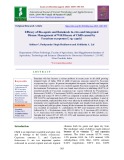
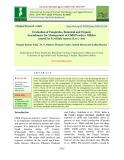

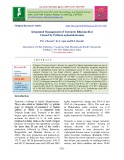





![Development of suitable IDM approaches for management of fusarium wilt of tomato [Fusarium oxysporum f.sp. lycopersici (Sacc.) Synder and Hansen] under climate change Development of suitable IDM approaches for management of fusarium wilt of tomato [Fusarium oxysporum f.sp. lycopersici (Sacc.) Synder and Hansen] under climate change](https://tailieu.vn/image/document/thumbnail/2020/20200614/gaocaolon5/135x160/8451592129684.jpg)


![Integrated management and host plant resistance against dry root rot [Macrophomina phaseolina (Tassi.) Goid] of chickpea Integrated management and host plant resistance against dry root rot [Macrophomina phaseolina (Tassi.) Goid] of chickpea](https://tailieu.vn/image/document/thumbnail/2020/20200516/nguaconbaynhay5/135x160/1181589615649.jpg)
